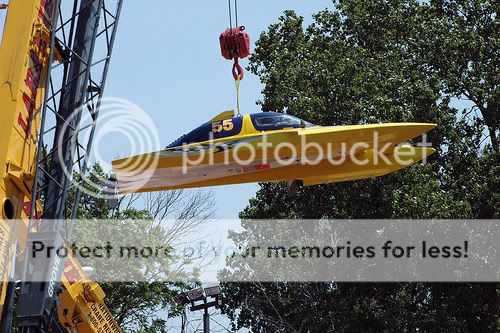What a bunch of sheep.
If movable wings are on EVERY unlimited hydro, and every class under them that allow it, I would be a bit hesitant to say "Its not worth the effort", or "It's already been tried".
How many examples are you refering to? This one example?
How about showing everyone the boat that "FAILED". Maybe the person setting it up didn't take in consideration a number of variables.
If movable wings didn't work with model powerboats, why do some of the rules ban the use of them???
I suggest keep going with the project and cast off any negetive input, and go kick some butt.
Back to the original question, the negetive angle of attack has to be determined by finding out its stall point where the wing does not generate the downforce to win over the drag it is creating. The best examples can be found on Top Fueler's - I would study some pictures of airfoil shapes and angles used on them, and/or keep stepping up to a larger square area of the wing or more of an angle untill your hull settles down the way you think it should.
My guess would be staying less than 10 degrees down. Anything more and I would think it would loose its purpose and only add drag.
I think the whole issue here is personal preference. I love to see wild build projects. Even if it doesn't make you go faster, it still sets you part from everyone else. I like to build what I like to build. I don't do it for anyone else but me. I think alot of the issue here is that the aero/hydro dynamics are different for a 30 ft hydro than a 2-3 ft hydro. If you really scale everything down. The engines that we put in these things far out power what is really in a scale hydro. Therefore we are pushing these little boats much harder, faster and farther than the full scale. Therefore, for the full scales to maximize performance they need alternative methods. With a scale boat we've already past that point of on the edge since the engines are so powerful. I've recently thought about using teflon bottom paint to reduce friction. After analyzing my theoretical solution, I decided it wouldn't make much difference. Think about this...... Drag is relatively proportional to surface area, 1 s.i. creates X amount of drag. If you have a 70 ft offshore hull x 10 ft wide x 1/5 (wet area) = 20,160 s.i = 20,160(X amount of drag). Okay now factor in your efficency ratio of the teflon paint, say 50%. 20,160 x 50% = 10,180 s.i. = 10,180 X amount of drag. Now that's a big difference. Just a hypothetical equation. Run that same calculation with a 4 ft boat. Back to the adjustable wing theory. Think about this, what is the difference in mass between a full scale hydro and a scale hydro? Our scale boats have much less mass, meaning they are lighter by volume. A full scale is heavier by volume. Since there's more mass to redirect (lift out of the water) you need additional means, other than just raw engine power and hydrologic lift to manipulate the mass. Another point to study, try to define the CG of a full scale hydro by analyzing the weight distribution. You can see that the CG is designed much farther back than our scale models. I've studied a few GP, UL & LTL hydros becuase I believe they are the closest to our sport hydros in size and design. You'll notice that the engine placement is much farther behind the trailing edge of the sponsons. Most scale sport hydros I have seen have the engine in front of the trailing edge setting the CG just behind the trailng edge. This is becuase (my personal hypothesis) of the greater mass of the full scale hydros. They need more force from the water to lift the transom in order to effectively produce lift with the airfoil. My point being that there are many different variables that affect the results of different techniques used on the full scale hydros vs. scale hydros, thus we use different methods to achieve similar results. Any way just my 2 cent. Any thoughts?
As far as any suggestions. I'd say build it in a manner that you can easily change every possible aspect of the design such as replace the wing with maybe a different size or different airfoil design. Then when setting it I would say start at zero and fine tune until you get optimum performance and then adjust in the turns and see what happens.







